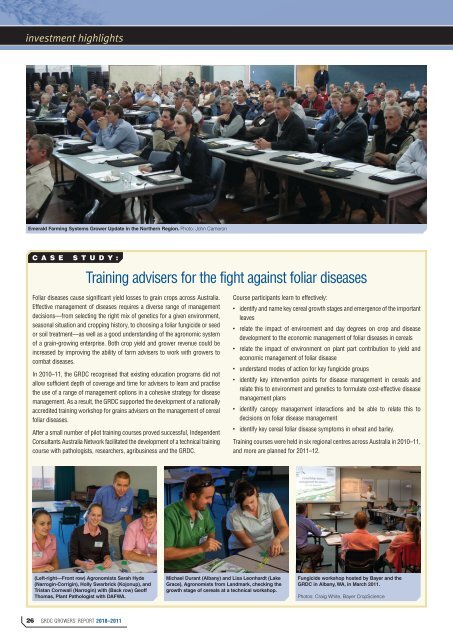grdc growers' report - Grains Research & Development Corporation
grdc growers' report - Grains Research & Development Corporation
grdc growers' report - Grains Research & Development Corporation
You also want an ePaper? Increase the reach of your titles
YUMPU automatically turns print PDFs into web optimized ePapers that Google loves.
investment highlights<br />
Emerald Farming Systems Grower Update in the Northern Region. Photo: John Cameron<br />
C A S E S T U D Y :<br />
Training advisers for the fight against foliar diseases<br />
Foliar diseases cause significant yield losses to grain crops across Australia.<br />
Effective management of diseases requires a diverse range of management<br />
decisions—from selecting the right mix of genetics for a given environment,<br />
seasonal situation and cropping history, to choosing a foliar fungicide or seed<br />
or soil treatment—as well as a good understanding of the agronomic system<br />
of a grain-growing enterprise. Both crop yield and grower revenue could be<br />
increased by improving the ability of farm advisers to work with growers to<br />
combat diseases.<br />
In 2010–11, the GRDC recognised that existing education programs did not<br />
allow sufficient depth of coverage and time for advisers to learn and practise<br />
the use of a range of management options in a cohesive strategy for disease<br />
management. As a result, the GRDC supported the development of a nationally<br />
accredited training workshop for grains advisers on the management of cereal<br />
foliar diseases.<br />
After a small number of pilot training courses proved successful, Independent<br />
Consultants Australia Network facilitated the development of a technical training<br />
course with pathologists, researchers, agribusiness and the GRDC.<br />
Course participants learn to effectively:<br />
• identify and name key cereal growth stages and emergence of the important<br />
leaves<br />
• relate the impact of environment and day degrees on crop and disease<br />
development to the economic management of foliar diseases in cereals<br />
• relate the impact of environment on plant part contribution to yield and<br />
economic management of foliar disease<br />
• understand modes of action for key fungicide groups<br />
• identify key intervention points for disease management in cereals and<br />
relate this to environment and genetics to formulate cost-effective disease<br />
management plans<br />
• identify canopy management interactions and be able to relate this to<br />
decisions on foliar disease management<br />
• identify key cereal foliar disease symptoms in wheat and barley.<br />
Training courses were held in six regional centres across Australia in 2010–11,<br />
and more are planned for 2011–12.<br />
(Left-right—Front row) Agronomists Sarah Hyde<br />
(Narrogin-Corrigin), Holly Swarbrick (Kojonup), and<br />
Tristan Cornwall (Narrogin) with (Back row) Geoff<br />
Thomas, Plant Pathologist with DAFWA.<br />
Michael Durant (Albany) and Lisa Leonhardt (Lake<br />
Grace), Agronomists from Landmark, checking the<br />
growth stage of cereals at a technical workshop.<br />
Fungicide workshop hosted by Bayer and the<br />
GRDC in Albany, WA, in March 2011.<br />
Photos: Craig White, Bayer CropScience<br />
26 GRDC GROWERS’ REPORT 2010–2011

















